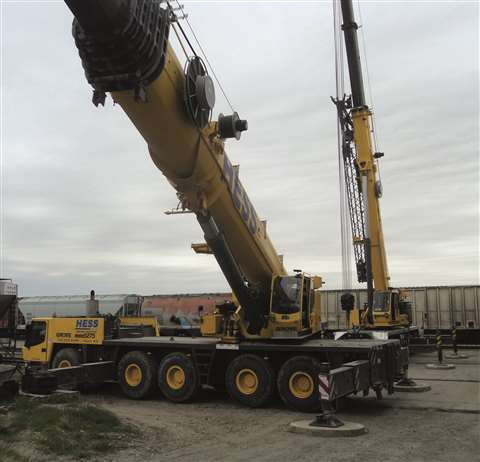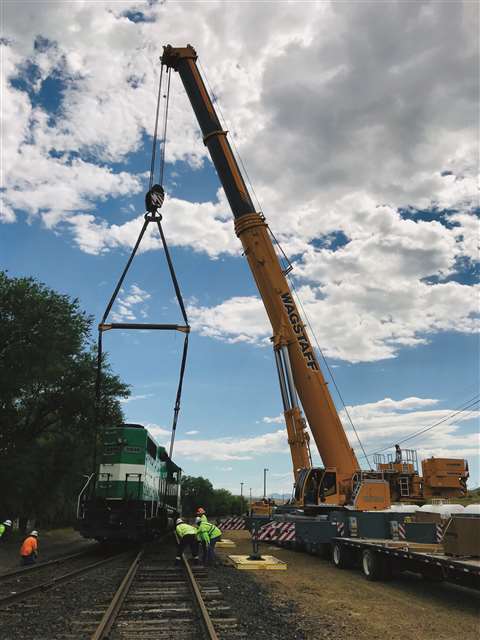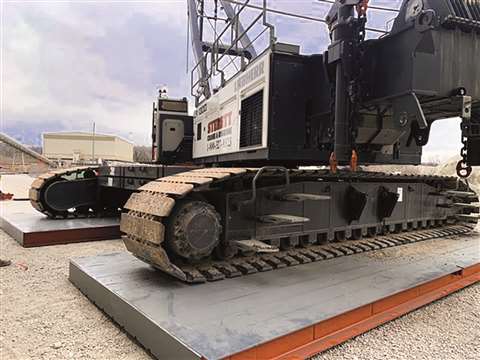Crane pad and mat makers discuss trends and issues
20 September 2022
Ground stabilization is among the most critical elements of safe crane operation. Whether you are operating a rough terrain crane and use mats made of wood, metal or synthetic materials or if you are running a huge crawler requiring steel mats, the importance of the mat or pad is the same.
 Lifton’s outrigger pads are made of multi-layer Baltic birch. The company provides a chart of suggested weights for the different size pads it makes.
Lifton’s outrigger pads are made of multi-layer Baltic birch. The company provides a chart of suggested weights for the different size pads it makes.
ACT talked to executives at four companies that produce crane mats and pads to discuss trends and issues in their respective markets. Those participating in our forum are Robert Lifton, Lifton’s Outrigger Pads; Josh Meyers, Greenfield Products; Daniel McCarty, Armor Mats; and Kate Lampson, Lampson International.
How do you characterize the market for crane mats and pads in North America?
LIFTON: The market has seemed to go up and down in terms of selling new pads. Currently the demand is back up to normal.
MEYERS: We have seen a steady increase in the demand for steel crane mats over the last few years. Crane users are seeing the long-term benefits of using an engineered steel mat with a PE stamped design. It instills confidence in the product and often leads to repeated business.
MCCARTY: The market needs new products and new ideas to address ground bearing pressure issues. Work site requirements are more stringent now than ever and the product options available for crane mats has not evolved.
LAMPSON: We are seeing a strong market and steady demand for our Lampson steel mat rentals.
What are the biggest issues your customers are facing in their decision to purchase and use crane pads and mats?
 Greenfield Products has patented its line of Smart Crane Mats that are 100 percent steel plate construction and designed with a 2-point-pick design that allows a single strap to pick a single mat, or a stack of mats and place them as desired.
Greenfield Products has patented its line of Smart Crane Mats that are 100 percent steel plate construction and designed with a 2-point-pick design that allows a single strap to pick a single mat, or a stack of mats and place them as desired.
LIFTON: The biggest concerns have to do with weight. Can the pad hold what they plan to use it for? We have a chart of suggested weights for different size pads that we make.
MEYERS: The three big questions for mats are: What size do I need? How much do they weigh? And of course, what do they cost? You need to find a nice balance of the three to provide the best setup for the user. Various sizes of mats can all work well with the same crane depending on the application. We want to understand that specific crane’s typical environment and requirements to provide a mat solution that makes the most sense. It’s common to hear about homemade mats, or something built by a local machine shop, but more people are seeing the benefit of using engineered mats from a company that will stand behind them.
MCCARTY: The industry needs to move to products and materials that have engineering data. Our customers cannot meet the engineering requirements because the products they are using do not have engineering data. Concerns are cost and availability of products that meet requirements. Armor Mats is offering a solution that is cost effective for rental or purchase.
 Greenfield Products has patented its line of Smart Crane Mats that are 100 percent steel plate construction and designed with a 2-point-pick design that allows a single strap to pick a single mat, or a stack of mats and place them as desired.
Greenfield Products has patented its line of Smart Crane Mats that are 100 percent steel plate construction and designed with a 2-point-pick design that allows a single strap to pick a single mat, or a stack of mats and place them as desired.
LAMPSON: I think the biggest issue facing our customers is ground bearing pressure and load spreading and which type of mat or pad is the best product for their project. Having been in business for over 75 years and working at refineries, power plants or on jobsites that have potentially unstable soil, it is a sound business practice of Lampson International to have our client hire a third party to conduct the ground studies, ground stabilization and any soil preparations. Whether it is a rough terrain crane, a boom truck or a heavy crawler crane, we take ground preparation very seriously.
Have you seen supply chain issues in terms of getting your products to your customers?
LIFTON: We use a special rope on our rope handle pads. The vendor had the ship his new supply was on get tangled in the California jungle of container ships. Then the container took one year to be shipped to him. Fortunately, we had enough in our stockpile, but it was a major headache that is now resolved.
MEYERS: We are always building mats for stock, and we have been able to stay ahead of any steel supply issues. Keeping mats in stock while also fulfilling customer orders requires us to purchase raw plate in very large quantities.
MCCARTY: No issues with supply chain.
LAMPSON: We have not had any supply chain issues to date.
 Armor Mats produces engineered steel mats from 4x20-foot to 12x40-foot surface area. These steel mats are engineered so Armor can supply data to calculate ground bearing pressure from the source to the site surface.
Armor Mats produces engineered steel mats from 4x20-foot to 12x40-foot surface area. These steel mats are engineered so Armor can supply data to calculate ground bearing pressure from the source to the site surface.
In terms of your company’s product line, what types of crane mats and pads seem to be the most popular among your customers at the present time?
LIFTON: Our bestselling pads are 36 inches in diameter in different thicknesses and our 24-inch square pad in different thicknesses as well. But we sell many pads in other sizes and thicknesses.
MEYERS: The mid-size mats are always popular – mostly various sizes in the 36 square feet to 60 square foot range (5x7 feet, 6x6 feet, 6x8 feet, etc.). We are also seeing an increasing need for the larger sizes like the 8x12 and 8x14 foot mats to accommodate the bigger cranes that are being produced these days.
MCCARTY: Armor Mats is solely focused on steel crane mats. We focus on addressing weight displacement and load bridging requirements for our clients.
LAMPSON: Our standard 4x16 foot steel crane mats seem to be the most in demand for conventional and ringer crane foundations, and our mudboats are widely used for large crawler crane foundations, jacking operation foundations and barge load/offload ramps.
STAY CONNECTED


Receive the information you need when you need it through our world-leading magazines, newsletters and daily briefings.




